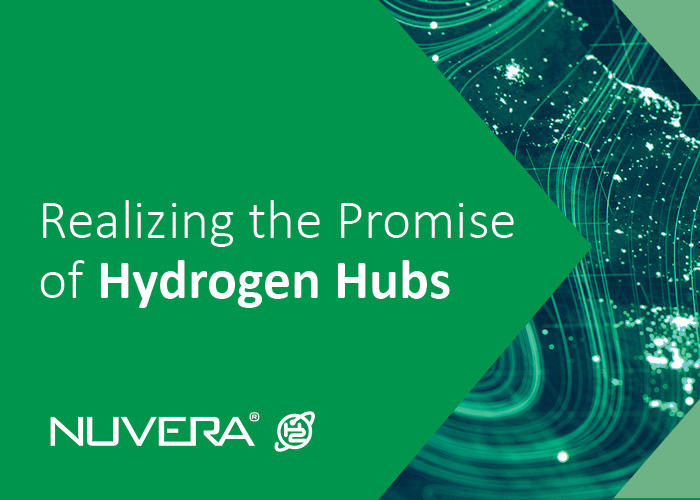President Biden and Energy Secretary Jennifer Granholm recently announced that seven regional clean “Hydrogen Hubs” will receive $7 billion in Bipartisan Infrastructure Law funding to accelerate the U.S. clean hydrogen market. These initiatives are projected to create more than $40 billion in private investment and create tens of thousands of new jobs – bringing the total public and private investment in Hydrogen Hubs to nearly $50 billion.
Advancing clean hydrogen is a vital component of President Biden’s vision for a strong clean energy economy. In 2022, Nuvera celebrated the momentum for the hydrogen transition jump-started by the Inflation Reduction Act, which marked the largest climate investment for the U.S. to date and includes the world’s largest tax credit for hydrogen production, along with other major incentives for fuel cell applications and industries that can be decarbonized with hydrogen.
Earlier in 2022, the administration released the U.S. National Blueprint for Transportation Decarbonization, a strategy for cutting all greenhouse emissions from the transportation sector by 2050 that relies significantly on the utilization of hydrogen and associated technologies. The 2021 Bipartisan Infrastructure Law allocates $65 billion in clean energy investments, including funding for the Regional Clean Hydrogen Hubs Program.
The Hubs selected for negotiation include:
- Mid-Atlantic Hydrogen Hub (Mid-Atlantic Clean Hydrogen Hub (MACH2); Pennsylvania, Delaware, New Jersey) — The Mid-Atlantic Hydrogen Hub will help unlock hydrogen-driven decarbonization in the Mid-Atlantic while repurposing historic oil infrastructure and using existing rights-of-way.
- Appalachian Hydrogen Hub (Appalachian Regional Clean Hydrogen Hub (ARCH2); West Virginia, Ohio, Pennsylvania) — The Appalachian Hydrogen Hub will leverage the region’s ample access to natural gas to produce low-cost clean hydrogen and permanently and safely store the associated carbon emissions.
- California Hydrogen Hub (Alliance for Renewable Clean Hydrogen Energy Systems (ARCHES); California) — The California Hydrogen Hub will leverage the Golden State’s leadership in clean energy technology to produce hydrogen exclusively from renewable energy and biomass. It will provide a blueprint for decarbonizing public transportation, heavy-duty trucking, and port operations—key emissions drivers in the state and sources of air pollution that are among the hardest to decarbonize.
- Gulf Coast Hydrogen Hub (HyVelocity Hydrogen Hub; Texas) — The Gulf Coast Hydrogen Hub will be centered in the Houston region, the traditional energy capital of the United States. It will help kickstart the clean hydrogen economy with its plans for large-scale hydrogen production through both natural gas with carbon capture and renewables-powered electrolysis, leveraging the Gulf Coast region’s abundant renewable energy and natural gas supply to drive down the cost of hydrogen—a crucial step to achieving market “liftoff.”
- Heartland Hydrogen Hub (Minnesota, North Dakota, South Dakota) — The Heartland Hydrogen Hub will leverage the region’s abundant energy resources to help decarbonize the agricultural sector’s production of fertilizer, decrease the regional cost of clean hydrogen, and advance the use of clean hydrogen in electric generation and for cold climate space heating.
- Midwest Hydrogen Hub (Midwest Alliance for Clean Hydrogen (MachH2); Illinois, Indiana, Michigan) — Located in a key U.S. industrial and transportation corridor, the Midwest Hydrogen Hub will enable decarbonization through strategic hydrogen uses including steel and glass production, power generation, refining, heavy-duty transportation, and sustainable aviation fuel.
- Pacific Northwest Hydrogen Hub (PNW H2; Washington, Oregon, Montana) — The Pacific Northwest Hydrogen Hub plans to leverage the region’s abundant renewable resources to produce clean hydrogen exclusively from renewable sources. Its anticipated widescale use of electrolyzers will play a key role in driving down electrolyzer costs, making the technology more accessible to other producers, and reducing the cost of hydrogen production.
As noted in the statement from the White House announcing the selections, clean hydrogen can reduce emissions in many areas of the economy and is critically important for hard-to-decarbonize sectors and industrial processes, such as heavy-duty transportation and chemical, steel, and cement manufacturing.
These U.S. federal initiatives signify an historic recognition of hydrogen’s potential. The Biden administration understands that hydrogen will unlock a strong clean energy economy that strengthens energy security, bolsters domestic manufacturing, creates healthier communities, and delivers new jobs and economic opportunities across the nation.
The most crucial – and tangible – next step toward tackling the climate crisis is a targeted investment in hydrogen’s production, delivery, and end-use. The Hydrogen Hubs will aim to produce more than three million metric tons of clean hydrogen per year, representing nearly a third of the 2023 U.S. clean hydrogen production goal. The seven Hubs have the potential to eliminate 25 million metric tons of carbon dioxide emissions each year.
Nuvera is creating real-world solutions to implement hydrogen fuel cell technology in many carbon-intensive applications, including heavy-duty road vehicles, port equipment and marine vessels. We stand ready to support the emergence of a robust hydrogen economy in response to the growing demand for zero-emission power solutions.

